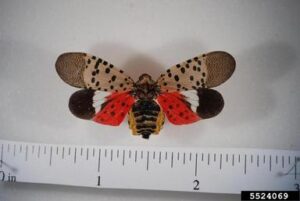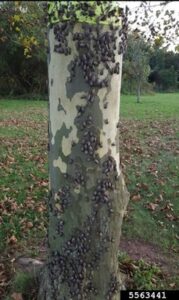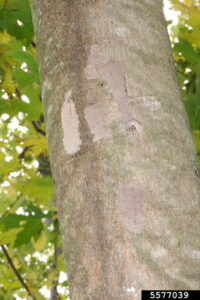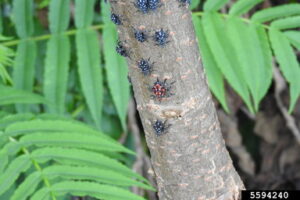South Carolina residents should be on the lookout for another invader: the invasive spotted lanternfly (Lycorma delicatula). Originally from Southeastern Asia, the spotted lanternfly (SLF) was first detected in Pennsylvania in 2014 and is now established in 14 surrounding states, reaching as far south as North Carolina.
Spotted lanternfly prefers Tree of Heaven (Ailanthus altissima) and Black Walnut (Juglans nigra) but will feed on other species. They will feed from over 100 plant species and are especially problematic for grape growers, where heavy feeding can significantly reduce yields. The SLF uses piercing mouth parts to feed from target plants, usually congregating in large numbers while they feed. As they consume the sap from plants, they also excrete waste, called honeydew, which can accumulate on surfaces below and turn them black.
Effective monitoring will include looking for egg masses that resemble smears of mud. Female SLF will lay eggs on any hard surface in winter, including trees, furniture, buildings, and cars. Eggs hatch in late spring, and the resulting nymphs will go through 4 instars or stages. The nymphs are about the size of a tick when they hatch, are black with white spots, and develop red patches as they grow. They mature into adults by mid-summer. Adults are about an inch long, with beige opaque forewings with black spots. Under their forewings, they have bright red hind wings with more black spots. The adults have a unique appearance and often congregate in large numbers to feed, moving up and down the tree at dawn and dusk.

Pennsylvania Department of Agriculture, Bugwood.org

Lawrence Barringer, Pennsylvania Department of Agriculture, Bugwood.org

Richard Gardner, Bugwood.org

Richard Gardner, Bugwood.org
How can you help prevent the spread of spotted lanternfly?
– Don’t transport firewood; instead, use wood local to where you plan to burn it.
– Check your vehicle for egg masses and adults before and after long trips.
– Destroy egg masses if you see them (after documenting them with pictures and location notes)
If you think you have found a spotted lanternfly, take a picture of it and make a note of the location. Upload the picture and additional information to the Clemson Department of Plant Industry Invasive Species Program SLF reporting tool and to iNaturalist.org.
Additional Resources:
HGIC 2025: Spotted Lanternfly
Land Grant Press 1008: Spotted Lanternfly Management in Nurseries, Orchards, Vineyards, and Natural Areas in South Carolina and Georgia Penn State Extension: Spotted Lanternfly Management
Author(s)
Tancey Belken, Cooperative Extension, Forestry and Wildlife Agent
This information is supplied with the understanding that no discrimination is intended and no endorsement of brand names or registered trademarks by the Clemson University Cooperative Extension Service is implied, nor is any discrimination intended by the exclusion of products or manufacturers not named. All recommendations are for South Carolina conditions and may not apply to other areas.
Clemson University Cooperative Extension Service offers its programs to people of all ages, regardless of race, color, gender, religion, national origin, disability, political beliefs, sexual orientation, gender identity, marital or family status and is an equal opportunity employer.
